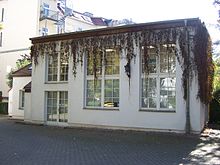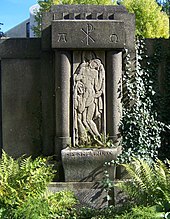Max Alfred Brumme
Max Alfred Brumme (born February 19, 1891 in Leipzig , † June 10, 1967 in Braunschweig ) was a German sculptor and painter.
Life
Max Alfred Brumme was the son of a bookbinder. He studied decorative and plastic design with Karl Groß and Georg Wrba at the Academy of Fine Arts in Dresden . He then continued his training as a sculptor with Adolf Lehnert in Leipzig.
Called up on November 2, 1914, Brumme served during the First World War in the infantry regiment "King Georg" (7th Royal Saxon) No. 106. In 1916 he became a lieutenant in the reserve and was on the front line until 1918. During the war, on August 12, 1918, he married Alma Margarethe Gläser.
After the end of the war, Brumme passed a teaching examination and became a teacher at the Leipzig School of Applied Arts . From 1927 he worked as a freelancer. Between 1939 and 1945 he created numerous monumental bronzes with which he was represented at all major German art exhibitions .
His main work includes the artistic design of the Gohlis Reconciliation Church , including a four-meter-high statue of Christ, an altar crucifix in the celebration church, drafts for the liturgical device and the war-accusing triptych that he created after the end of the Second World War . In addition to many works of art with Christian references, Brumme also made numerous profane portraits, including a portrait bust of Adolf Hitler for the City Hall in Leipzig. The marble monument to the fallen on the portal of the St. Peter's Church in Leipzig on Gaudigplatz was also made by him. His work has contributed as a signature the initials "M. Alf. Hum ”.
As early as 1962, the artist acquired a grave on the east wall of the Leipzig-Gohlis cemetery, which he had furnished with a Pietà relief designed by his student Hans-Joachim Förster . After the death of his wife in 1965 Brumme came to Braunschweig by way of family reunification, where he spent his old age with his children. He died in 1967; his ashes were buried in the cemetery in Leipzig-Gohlis.
Works (selection)
Pietà Grabmal Ahlswede, restored in 2015 on behalf of the Paul Benndorf Society
- Borna - figure soldier and worker , in front of the former main guard anti-tank defense
- Delitzsch - Well system recovery , in the city park
- Schkeuditz - war memorial
- Böhlitz-Ehrenberg - Interior of the prayer hall in the parish hall
- Zwickau: Robert Schumann bust, bronze, Robert Schumann House
- Grossenhain - Hussar memorial for the former 1st Hussar Regiment "King Albert"; Inauguration on May 27, 1934, 1948 removed
- Eilenburg - Relief in memory of Martin Rinckart at the Nikolaikirche (1936)
- Bad Köstritz - bust of Heinrich Schütz on the Heinrich Schütz monument, 1936
- Leipzig - Bahnpostamt Rohrteichstraße, relief, 1935
- Leipzig - Sea lion and bear group, sculptures on the portal of the former zoological institute of the University of Leipzig , Talstrasse
- Leipzig - Monument to the fallen at the entrance of the Peterskirche on Gaudigplatz
- Leipzig - Design of the Connewitz and Lindenau cemetery chapels , the White Hall at the zoo
- Leipzig - Südfriedhof , Herrmann tomb, III. Dept.
- Leipzig - Südfriedhof, Gnant Tomb, XII. Dept.
- Leipzig - Südfriedhof, tomb Eugen Mogk , II.
- Leipzig - Südfriedhof, tomb Anton Käppler, X. Abt.
- Leipzig - Südfriedhof, grave of Oswald Fiedler, V. Abt.
- Leipzig - Südfriedhof, Herrmann Ahlswede Tomb, XI. Dept.
- Leipzig - Südfriedhof, Kaps tomb, last major work by the artist
- Leipzig - stained glass window Paul-Gerhardt-Church Connewitz
- Leipzig - Stained glass window Friedenskirche, Leipzig-Gohlis
- Leipzig - Göbschelwitz Church , altarpiece and stained glass window
- Leipzig - Regimental monument 1914–1918 of the (Reserve) Infantry Regiment No. 473
- On a single-level substructure, the statue is connected to the base using the same material. It shows a bareheaded infantryman with his legs apart, wearing a coat and holding his steel helmet in his right hand. The gaze is fixed straight ahead on the floor. The inscription on the base is dedicated to the monument "THE DEAD / COMMERCIALS".
literature
- General artist lexicon . Vol. 14, 1996, p. 522.
- Brumme, Max Alf (red). In: Horst Riedel: Stadtlexikon Leipzig from A to Z. Leipzig 2005, p. 72.
- Andreas Peschel: The Hussar Monument would be 75 years old today. In: Saxon newspaper . Großenhainer edition. May 27, 2009.
- Kurt Hoffmeister : The artist M. Alf Brumme: * 1891 in Leipzig, † 1967 in Braunschweig; Life and work. Self-published, Braunschweig 2002.
- Christian Mai: The artistic design of the Reconciliation Church by M. Alf Brumme. In: Friends of the Reconciliation Church Leipzig-Gohlis e. V. (Ed.): The Reconciliation Church in Leipzig-Gohlis. History and present of a building of classical modernism. Pro Leipzig, Leipzig 2009, ISBN 978-3-936508-46-8 , pp. 48-58.
- Alfred E. Otto Paul: The art in silence. Art treasures in Leipzig cemeteries. No. 3, Leipzig 2010, p. 34ff.
Web links
- Literature by and about Max Alfred Brumme in the catalog of the German National Library
- Works at the Great German Art Exhibition in Munich
Individual evidence
- ↑ In the course of a competition in 1935, Brumme submitted the - not executed - draft of a war memorial for the Peterskirch community in Leipzig, the inscription of which was to read: “Holy battle for German land, Holy sword in warrior's hand, Holy blood, consecrated to victory, thanks You in eternity! ”Cf. Sebastian Kranich : The war memorial in front of the St. Peter's Church in Leipzig - a problem. In: Herbergen der Christenheit, Vol. 28/29 (2004/2005). Evangelische Verlagsanstalt, Leipzig 2006, ISBN 978-3-374-02341-7 , pp. 281–288.
| personal data | |
|---|---|
| SURNAME | Brumme, Max Alfred |
| BRIEF DESCRIPTION | German sculptor and painter |
| DATE OF BIRTH | February 19, 1891 |
| PLACE OF BIRTH | Leipzig |
| DATE OF DEATH | June 10, 1967 |
| Place of death | Braunschweig |







